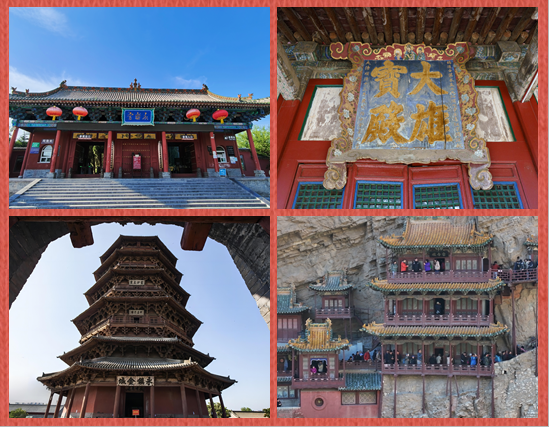Shanxi pours effort into ecosystems
Updated: 2025-04-14
River chief system hailed as innovative way to protect and reinvigorate waterways across province
Spring is a vibrant season in the North China province of Shanxi, where rivers and lakes are fuller with the thawing of ice and snow, trees along the banks begin to bloom and migrant birds return.
The scene is not just a natural process but the result of human efforts to protect the environment. In recent years, the province has rolled out a series of rules and regulations and implemented innovative practices to accelerate the protection of rivers and lakes.
With substantial improvements in water quality and the ecosystem, Shanxi, a province in the middle reaches of the Yellow River, is striding toward its goal of becoming an important experimental zone for ecological protection and high-quality development in the river's drainage region.
One innovative practice for protecting Shanxi's water environment and wetland ecosystem is the river chief system.
Shanxi began to implement the river chief system in 2017. A river chief is usually the chief of the local committee of the Communist Party of China and head of the government, responsible for a section of the local river. The system is also applicable for lakes and other water bodies throughout the province.
Shanxi's water bodies are now taken care of by more than 22,000 river and lake chiefs at the village, township, county, city and provincial levels. The river chiefs' tasks are ensuring the river's environment is protected and helping raise residents' awareness of environmental protection.
Zhang Ronghuai (1916-2005), the first secretary of the CPC committee of Youyu, is regarded by locals in this northern Shanxi county as one the pioneering river chiefs in the province because of his contribution to curb the Cangtou River, although he didn't get such a title in his lifetime.
A tributary of the Yellow River, the Cangtou is deemed as the mother river of Youyu as it is the largest in the county and has nurtured life and development for thousands of years.
However, the river was not always beneficent in history. According to local residents, the Cangtou was even regarded a harmful river some seven decades ago. In rainy seasons, it flooded farmlands, destroyed properties and claimed lives. In dry seasons, its riverbeds were a source of sandstorms.
Zhang, who took the post as Youyu's Party chief in 1949, then recognized that severe soil erosion was the biggest reason that made the Cangtou harmful. He then began to curb this through greening efforts.
In 1950, he and his colleagues ordered the planting of trees and grasses along the barren banks of the river. This greening program was later expanded to hills and mountains near the river and beyond, basically curbing soil erosion over the following decades.
The county's forest coverage rate has increased from less than 0.3 percent in the 1950s to 57 percent now, creating a marvel in human ecology. Youyu was honored with the New Sustainable Cities and Human Settlements Award during the 19th Annual Sessions of the Global Forum on Human Settlements, and the New Sustainable Cities and the Human Settlements Awards Ceremony held at the United Nations Headquarters in New York in October.
The Cangtou River area has also developed into a provincial-level protection zone for wetlands and a major scenic belt. While offering habitat to hundreds of wildlife species, it has attracted millions of tourists to see how this once barren land transformed into an oasis.
The greening efforts have helped the Cangtou make the list of China's rivers and lakes that generate a sense of happiness among locals, which was announced on March 22.
There are 60 sections of rivers and lakes in Shanxi included in the list. On the list, Salt Lake in the southern Shanxi city of Yuncheng is a shining example of environmental protection.
Covering an area of 132 square kilometers, Yuncheng Salt Lake is one of three famed inland lakes with sodium sulfate – a bitter salt used especially in detergents – in the world.
The lake served as a salt production base for about 4,600 years, according to local history documents. When production reached its peak decades ago, the local ecological environment was severely challenged, according to Diao Haipeng, vice-mayor of Yuncheng city.
"These environmental challenges included pollution, damage to embankments, a decrease in vegetation along the lake and silting-up of watercourses," Diao said. "After millennia of prosperous growth, the lake needed to slow down its pace of development and have a respite."
To protect this gem, the government of Yuncheng ordered a halt to salt mining in 2020 and began an environmental improvement program in 2021.
The official said that the program included dredging the lake and its connected watercourses, enhancing 98 km of embankments and planting a vegetation belt along the lake.
The lake's water is supplied by streams originating from the neighboring Zhongtiao Mountains. The Zhongtiao area is another target of environmental improvement, according to Diao.
"The mineral-rich Zhongtiao streams are the lifelines for the lake," Diao said. "Through increasing vegetation coverage and economized use of water among residents and businesses, the streams' runoff into the lake has been increasing steadily over recent years."
The vice-mayor added that the streams' annual supply of saline minerals to the lake has now reached about 200,000 metric tons, among the best levels in history.
After several years of efforts, Yuncheng Salt Lake has seen a steady improvement in its environment. The lake is now a better habitat for birds and other wildlife species. More than 200 bird species have been recorded in recent years, including such rare varieties as flamingo, swan, pied avocet and great bustard, according to local environmental officials.
The flamingo is an endangered species of stork mainly living in Africa, Central Asia and South Asia. Records show that the birds were first discovered in China in the late 1990s. Now the city of Yuncheng has become a favored winter habitat of the bird.
When salt production temporarily closed at the lake, Diao said how to guarantee revenue was a concern among residents, businesses and officials.
The official noted that production will resume when the improvement program is completed, but in a rational scale aiming to strike a balance between environmental protection and economic growth. He said additional revenues will come from tourism and industries derived from salt production.
One example is the development of products based on black mud from the lake bed. Black mud is a resource unique to Yuncheng Salt Lake. Containing fulvic acid and 38 varieties of minerals, the mud is used to make products for healthcare, skin care and crop care.
Yuncheng Salt Lake has become a tourist destination in Shanxi province, which has developed into a major stream of revenue.
The tourism industry highlights both the historical tradition of salt mining and innovative scenarios meeting the taste of modern-day tourists.
"On this lake, known as the Chinese version of the Dead Sea, floating on the water's surface is an unforgettable experience that you can never find elsewhere in the country," said a tourist on his WeChat account.
In recent years, the lake again became a hit on social media because of eye-catching aerial photos of its colorful surface. As temperatures begin to rise in early summer, the multicolored Salt Lake becomes a busy attraction for tourists and photographers.
Scientists attribute the rich colors of the lake to the propagation and growth of halophilic algae and brine shrimp. The organisms change color at various temperatures, turning the lake into a huge painter's palette.
Another lake on the nation's "happy rivers (lakes)" list is Yunzhu Lake in Yushe county, Jinzhong city. It is a large reservoir in the southwest of the county, which was created in the early 1960s.
Covering 1,416 hectares and boasting four wetland parks and more than 30 scenic attractions, Yunzhu Lake is one of the top tourist destinations in the county.
Liu Feng, a resident of Pianliang village in its vicinity, said it is fortunate to live by a picturesque lake.
Liu operates a bed-and-breakfast business in his village. Thanks to growing numbers of tourists, the business generated an annual net income of more than 100,000 yuan ($13,630) for his family in recent years.
"Yunzhu was not a tourist destination at the beginning," Liu said. "It became one several years ago after the county government invested nearly 1 billion yuan in local environmental improvements and landscaping."
He said there are hundreds of people involved in the tourism industry after the lake and its vicinity became a destination.
Pianliang also invested 4.6 million yuan in improving local infrastructure, such as roads and water treatment facilities, laying a foundation for tourism development, according to a village official.
The official said the tourism industry has brought an additional per capita net income of more than 3,000 yuan for its residents annually.
Shen Qinfang and Li Keying contributed to this story.

A Yellow River reservoir in Yuanqu county now features clean waters and mountains covered with lush vegetation. XUE JUN/FOR CHINA DAILY

Willow trees near a lake in Taiyuan's Yingze Park begin to sprout in early spring. LI ZHAOMIN/FOR CHINA DAILY

More than 200 cranes are spotted on the Sanggan River wetland in Datong on Oct 25. WEI XIANGDONG/LIU LIYUAN/FOR CHINA DAILY

Yuncheng Salt Lake becomes a patchwork quilt of colors in warm weather thanks to its algae. XUE JUN/FOR CHINA DAILY

Yunzhu Lake in Yushe county is an emerging tourist destination in Shanxi thanks to the government's effort in environmental protection. LI XIANJUN/FOR CHINA DAILY



